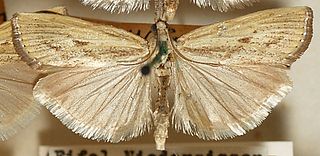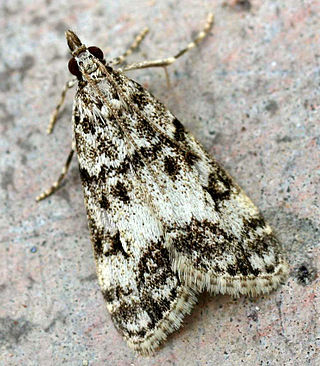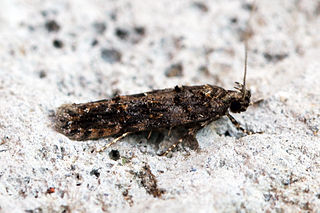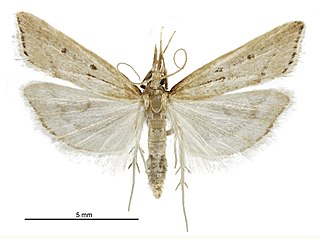
Apamea sordens, the rustic shoulder-knot or bordered apamea, is a moth of the family Noctuidae. The species was first described by Johann Siegfried Hufnagel in 1766. It is distributed throughout Europe, east across the Palearctic to Central Asia and to China and Japan. It also occurs in North America.

Pempelia palumbella is a moth of the family Pyralidae. It is found in Europe.

Agriphila inquinatella is a small moth species of the family Crambidae. It is found in Europe, around the Caucasus area to Turkestan, and in the Near East to Jordan. The type locality is in Austria.

Agriphila tristella, the common grass-veneer, is a species of moth of the family Crambidae found in Europe and Asia.

Pyrausta despicata, the straw-barred pearl, is a species of moth of the family Crambidae. It was described by Giovanni Antonio Scopoli in his 1763 Entomologia Carniolica.

Udea prunalis is a moth of the family Crambidae. It is found in Europe and China. The species was first described by Matthew Denis and Ignaz Schiffermüller in 1775. In the Butterfly Conservation's Microlepidoptera Report 2011 this species was classified as common in the UK.

Scoparia ambigualis is a species of moth of the family Crambidae described by Friedrich Treitschke in 1829. It is found in Europe and Asia Minor and possibly in Guangdong and Shanxi in China.

Eudonia lacustrata is a species of moth of the family Crambidae described by Georg Wolfgang Franz Panzer in 1804. It is found in Europe, north-west Africa, Asia from Turkey, Iran and Syria to Siberia and the western part of China (Hunan). The subspecies E. lacustrata persica is found in Iran and Armenia.

Eudonia truncicolella is a species of moth of the family Crambidae described by Henry Tibbats Stainton in 1849. It is found in China, Japan west to Europe.

Anania fuscalis is a species of moth of the family Crambidae. It is found in Europe.

Scoparia pyralella, the meadow grey, is a species of moth of the family Crambidae. It was first described by Michael Denis and Ignaz Schiffermüller in 1775.

Teleiopsis diffinis is a moth of the family Gelechiidae. It is found in Europe, North Africa, the Near East, central Asia and Siberia (Transbaikalia).

Gypsonoma aceriana, the poplar shoot-borer, is a moth of the family Tortricidae. It is found from Europe to Russia, eastern Turkey and Iraq. It is also present in North Africa.

Chrysoesthia sexguttella, the orache leafminer moth, is a moth in the family Gelechiidae. It is found in all of Europe, east to southern Siberia, as well as the north-eastern parts of North America, where it might be an introduced species.

Eudonia angustea is a moth of the family Crambidae described by John Curtis in 1827. It is found in southern and western Europe, the Canary Islands, Madeira and Turkey.

Antiscopa elaphra is a moth in the family Crambidae. It is endemic to New Zealand and has been observed in both the North and South Islands. Adults of this species are on the wing from August until March and are attracted to light. In 2020 this species had its DNA barcode sequenced.
Helcystogramma malacogramma is a moth in the family Gelechiidae. It was described by Edward Meyrick in 1909. It is found in Zimbabwe and Gauteng, South Africa.

Scrobipalpa instabilella, the saltern groundling, is a moth in the family Gelechiidae. It was described by John William Douglas in 1846. It is found in on the Canary Islands, in Algeria, Ireland, Great Britain, Portugal, Spain, France, Belgium, the Netherlands, Germany, Denmark, Italy, Sardinia, Sicily, Greece, Cyprus and Palestine. It is also present in the United States, where it has been recorded from California.
Untomia melanobathra is a moth of the family Gelechiidae. It was described by Edward Meyrick in 1918. It is found in Ecuador.

Eriopygodes imbecilla, the Silurian, is a moth of the family Noctuidae first described by Johan Christian Fabricius in 1794.


















